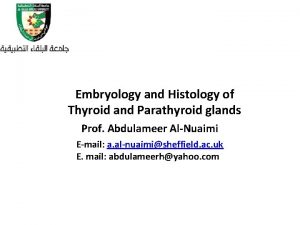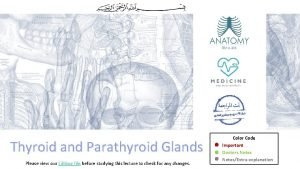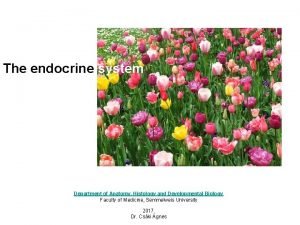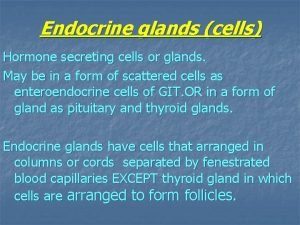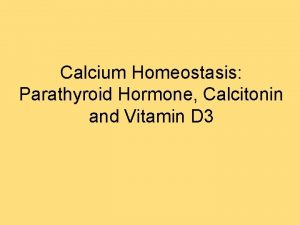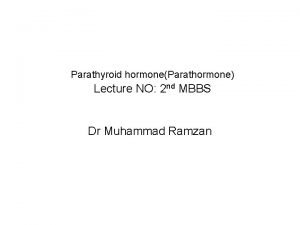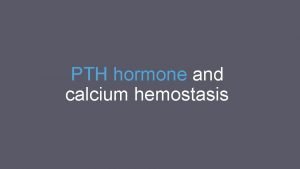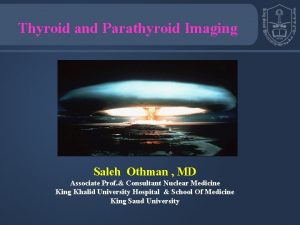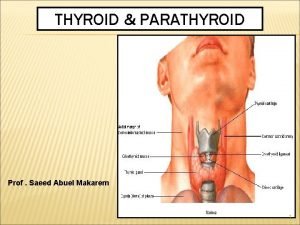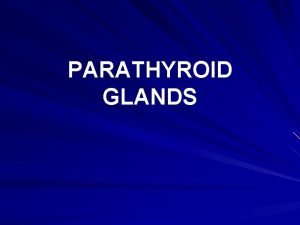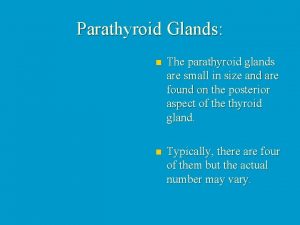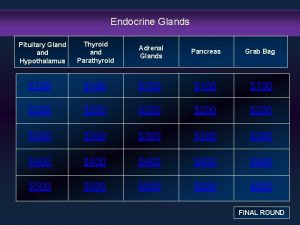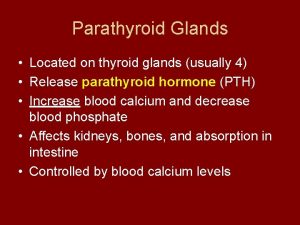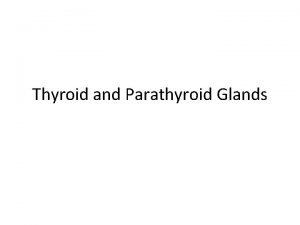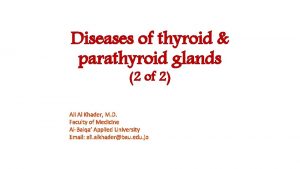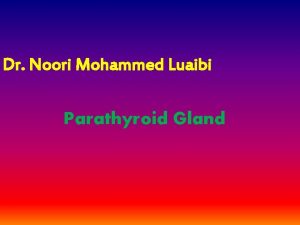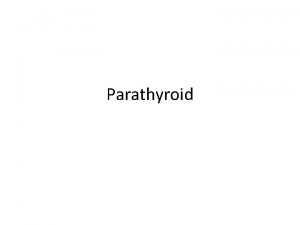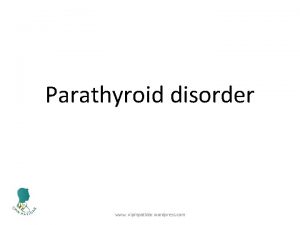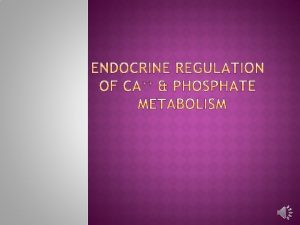Diseases of thyroid parathyroid glands 1 of 2












- Slides: 12

Diseases of thyroid & parathyroid glands (1 of 2) Ali Al Khader, M. D. Faculty of Medicine Al-Balqa’ Applied University Email: ali. alkhader@bau. edu. jo

Thyroid diseases Thyrotoxicosis Hypothyroidism Chronic Lymphocytic (Hashimoto) Thyroiditis Subacute Granulomatous (de Quervain) Thyroiditis Subacute Lymphocytic Thyroiditis Graves disease Neoplasms Goiters adenoma carcinoma Riedel thyroiditis Hyperfunctioning (toxic) Nontoxic

Thyrotoxicosis *A hypermetabolic state due to increased T 3 & thyroxine (T 4) in the blood Increased production from thyroid gland (hyperthyroidism) Exogenous in thyroiditis The most common cause of thyrotoxicosis Primary Secondary (central) …rare …from TSH-secreting pituitary adenoma Toxic (hyperfunctional) multinodular goiter Graves Disease …the most common cause of hyperthyroidism Release of preformed hormones from destroyed gland Toxic (hyperfunctional) adenoma 1 - Granulomatous (de Quervain) thyroiditis (painful) 2 - Subacute lymphocytic thyroiditis (painless) *Thyrotoxicosis also can occur in Hashimoto thyroiditis (Hashitoxicosis)

Clinical manifestations of thyrotoxicosis • Soft, warm & flushed skin…due to peripheral vasodilation to increase heat loss • Heat intolerance and excessive sweating • Weight loss in spite of normal or even increased appetite In cases of infection, surgery, cessation of anti-thyroid medication, or any form of stress…a thyroid storm may occur …especially in Graves …risk of fatal arrhythmia • Rapid transit time (hypermotility) of the gut… diarrhea and fat malabsorption (steatorrhea) • Palpitations and tachycardia…due to increased cardiac contractility & increased tissues oxygen requirements…may cause high cardiac output heart failure • Nervousness, tremor and irritability • Proximal muscle weakness (thyroid myopathy) • Ocular changes (wide, staring gaze and lid lag) • Thyroid ophthalmopathy: (wide, staring gaze and lid lag) + exophthalmos (proptosis)… in Graves disease • Apathetic hyperthyroidism…in older adults…typical thyrotoxicosis features are blunted and only present with exaggerated heart disease or weight loss

Clinical scenarios The thyroid function test (TFT) • Low T 4 and high TSH = 1 ry hypothyroidism *We measure free T 4 & free T 3. . . these have the feedback on TSH *T 3 is stronger than T 4 in activating receptors…T 4 is converted to T 3 peripherally *Minor change in T 3/T 4 will cause a large change in TSH level *Most of the time we take free T 4 & TSH and analyze their levels for the diagnosis • Normal T 4 and high TSH = subclinical 1 ry hypothyroidism If we want to choose 1 test, TSH is the best • Low T 4 and low TSH = central hypothyroidism • Low T 4 and normal or mildly elevated TSH = also central hypothyroidism • High T 4 and low TSH = non-central hyperthyroidism • Normal T 4 and low TSH hyperthyroidism check T 3 (if high: T 3 thyrotoxicosis), if T 3 is not high • High T 4 and high TSH = central hyperthyroidism • High T 4 and normal or mildly decreased TSH = also central hyperthyroidism subclinical non-central

Approach to thyrotoxicosis patient • • Thyroid scan is different from thyroid uptake The examples and scenarios mentioned here are not all examples, but they are enough at this level *If central hyperthyroidism, do pituitary MRI *If non-central hyperthyroidism: …do uptake …if the uptake is high, do scan, it may be Graves (in scan: homogenous) or toxic adenoma (in scan: 1 spot) or toxic multinodular goiter (in scan: multiple spots) …if the uptake is low, measure thyroglobulin, if it is high: thyroiditis (because thyroglobulin increases also with cell destruction), if it is low or normal: it may be factitious (exogenous) In thyroid scan we use a radioactive iodine or technetium and see the distribution of its uptake in the gland…it shows if a nodule is over-uptaking (a toxic adenoma for example) or homogenous overuptake (Graves disease for example) • In thyroid uptake, we give the iodine or technetium and just count the percentage of uptake to know if high- or low uptake Thyrotoxicosis with high 24 -h RAI uptake Thyrotoxicosis with low 24 -h RAI uptake Graves disease Factitious Multinodular goiter Subacute (painless) thyroiditis Toxic adenoma Granulomatous (painful) thyroiditis RAI: Radioactive iodine Like using iodinated contrasts for imaging Secretion from struma ovarii (ovarian teratoma containing mostly thyroid tissue) Iodine-induced hyperthyroidism

Hypothyroidism Secondary (pituitary or hypothalamic failure) …rare This label means: can cause enlargement (goiter) = Goitrous hypothyroidism Primary Congenital Autoimmune Hashimoto thyroiditis Genetic Thyroid dysgenesis (problem in thyroid tissue development) Dyshormonogenetic goiter (problem in thyroid hormone production) Iatrogenic The most common cause in countries where iodine is supplemented in dietary salt products As a side effect -lithium -iodides -p-aminosalicylic acid Ablation Surgical ablation Ablation by radioiodine therapy Ablation by external radiation rare but the most common cause of congenital hypothyroidism in the U. S. Endemic deficiency of dietary iodine a common cause of hypothyroidism in infants and children worldwide

Clinical manifestations of hypothyroidism • Cretinism in infancy or early childhood and myxedema in older children and adults -Protruding tongue -Growth retardation with short limbs -Coarse dry skin -Lack of hair and teeth -Mental deficiency -Pot belly -Often umbilical hernia -Hypotonia *Glycosaminoglycans with associated water are the cause of myxedematous fluid accumulation Rubin, Raphael, David S. Strayer, and Emanuel Rubin, eds. Rubin's pathology: clinicopathologic foundations of medicine. Lippincott Williams & Wilkins

Thyroiditis Chronic Lymphocytic (Hashimoto) Thyroiditis -mainly 45 -65 years, but any age -Females more -CD 8, IFN-gamma, other cytokines, macrophages, anti-thyroglobulin, antithyroid peroxidase -Goiter with too many lymphocytes including germinal centers with destruction of follicles, Hurthle (oxyphil) cell change and fibrosis…may end with atrophy -CTLA-4 mutations Subacute Granulomatous (de Quervain) Thyroiditis -30 -50 years -Females more -Viral infection-induced …not autoimmune -A majority of patients have a history of an upper-respiratory infection shortly before the onset of thyroiditis -painful -usually self-limited -destroyed follicles, extravasated colloid with exuberant granulomatous reaction Subacute Lymphocytic (Painless) Thyroiditis -Sometimes after delivery (postpartum thyroiditis) -Autoimmune (antithyroid antibodies in majority of patients) -middle-aged women -usually self-limited Riedel Thyroiditis -extensive fibrosis involving the thyroid and contiguous neck structures -an Ig. G 4 -related disease The manifestations range from thyrotoxicosis to euthyroid state to hypothyroidism Patients with Hashimoto thyroiditis often have other autoimmune diseases and are at increased risk for the development of B-cell non-Hodgkin lymphomas in thyroid Elsevier. Kumar et al. Robbins and Cotran pathologic basis of diseases 9 th

Graves disease Diffuse goiter + thyrotoxicosis + (in 40%) infiltrative ophthalmopathy (exophthalmos) + (in a minority of patients) infiltrative dermopathy (pretibial myxedema) Pseudopapillae (no fibrovascular cores) *20 -40 years *Women more *1. 5% to 2% of women in the United States…not uncommon *Genetic predisposition *HLA-DR 3, CTLA-4 & PTPN 22 *Elevated antibodies: -TSI (thyroid-stimulating immunoglobulin) …an Ig. G …specific & in all patients -Thyroid growth-stimulating immunoglobulins -TSH-binding inhibitor immunoglobulins *Exophthalmos is caused by retroorbital Inflammation & increased retroorbital connective tissue/glycosaminoglycans, muscle & fat *Associated with other autoimmune diseases Elsevier. Kumar et al. Robbins and Cotran pathologic basis of diseases 9 th Lymphocytic infiltrate with germinal centers is common …not shown Elsevier. Kumar et al. Robbins basic pathology 10 …modified th Hypertrophy & hyperplasia of follicular epithelial cells

Goiter • Regarding the previously mentioned goitrous diseases (other than Graves): …Early in goiter development, TSH-induced hypertrophy and hyperplasia of thyroid follicular cells usually result in diffuse, symmetric enlargement of the gland (diffuse goiter) …Virtually all long-standing diffuse goiters convert into multinodular goiters Clinical manifestations: -Cosmetic problem of a large neck mass -It may cause airway obstruction or dysphagia -It may cause compression of large vessels in the neck and upper thorax (so-called “superior vena cava syndrome”)

Thank You

